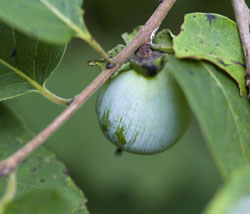Persimmons
Searcy, Ark. –
 If you have ever eaten a common persimmon before a frost, you know the definition
of “pucker power”. The fruits can be quite astringent. But this year the trees are
loaded with fruit and if you like persimmons, let them fully mature, and then start
harvesting.
If you have ever eaten a common persimmon before a frost, you know the definition
of “pucker power”. The fruits can be quite astringent. But this year the trees are
loaded with fruit and if you like persimmons, let them fully mature, and then start
harvesting.
The common persimmon, Diospyros virginiana, is a slow-growing, mid‐sized native tree with fruits that ripen in the fall. The Latin name means “food of the gods”. While a frost is really not needed to ripen the fruits, they do require a long season to get fully ripe, and if not ripe, they will be astringent, bordering on inedible.
What growing conditions do native persimmons prefer?
The native persimmon is a very adaptable tree, growing in most soil types in full sun to partial shade. Persimmon trees will withstand short periods of drought, but the fruit will be larger and of higher quality with regular watering. Extreme drought will cause the leaves and fruit to drop prematurely. At maturity a common persimmon tree can be 40 feet tall. It has hard, dark and beautifully grained wood. A lot of the large old trees were cut to make golf clubs during the early years of the 20th century and are still used in specialized furniture pieces.
How are native persimmons pollinated?
Our native persimmon tree is dioecious, which means there are separate male trees and separate female trees. You need one of each to have fruit, and only the female tree will bear fruit. While persimmons can be grown from seed, it can take 4‐9 years before they begin to bloom and then you need to determine if they are male or female. Most trees in the trade are grafted, and can begin to bear fruit in 3‐6 years. A few varieties of the native persimmon have been found to be self‐fruitful, but a bit hard to find. ‘Meador’ is one that is self‐fruitful.
When should persimmons be harvested?
Mature fruit may be yellow, orange, bright red, or bluish in color. Fruit becomes soft and mushy when ripe. Unripe fruit, which is high in tannins, has a bitter astringent flavor, thus the pucker‐power. The mature fruit are very sweet when fully ripened and astringency is reduced. Some pointers to help you know when to harvest is that when the fruit is ripe it will pull away easily from the branch, turn a deep color and be soft to the touch.
Edible fruits often hang on the trees through fall, and even into winter, unaffected by freezing temperatures. Songbirds, raccoons, squirrels, and deer are some of the animals which enjoy the extra fruit in the late fall and winter.
A slightly, more decorative cousin to the common persimmon is the oriental persimmon tree. The oriental persimmon is native to China, where it has been grown for centuries. It is also the national fruit of Japan. It came to the United States in the mid‐1800’s starting in California, and now they are grown in roughly half of the US. Oriental persimmon fruit ripens from late August until early December, depending on the variety and weather conditions. Fruit size can vary from squatty round fruits to large almost grapefruit‐sized fruits. Fuyu‐Gaki persimmon is the most widely planted cultivar in the world. When fully ripe, this fruit turns a crimson red with a blue blush. It is also self‐fruitful. Other self‐fruitful varieties include Gionbo with very large (4‐5") orange conical, astringent fruits, Great Wall, and Matsumoto. Most oriental persimmon trees grow about 15 feet tall and wide. With the oriental persimmons, some are self‐fruitful and others need another variety for pollination. These are smaller trees at maturity, so fit into a landscape a bit easier.
If you like persimmons, you can’t go wrong with either type of tree. If you are into folklore, now is also a good time to look for the weather prognosticator. Harvest the fruit of the native persimmon, find the seeds and cut them in half. This is not easily done since they are quite slippery. Inside each seed will be a white embryo in the center. They are generally shaped as either a "fork", "knife", or "spoon". If you see a fork, it means a mild winter. A spoon means lots of snow—a spoon for shoveling, and a knife means a cold winter ahead—it will cut like a knife! So far, we have seen all spoons, so if the persimmons are right, it will not be a pleasant winter! But to be honest, it said that last year and we didn’t have a winter!
For more information you can contact your local county extension service, you can also follow Sherri Sanders on Facebook @UADA.WhiteCountyAgriculture
###
By Sherri Sanders
White County Extension Agent - Agriculture
U of A Division of Agriculture
Cooperative Extension Service
2400 Old Searcy Landing Road Searcy AR 72143
(501) 268-5394
ssanders@uada.edu